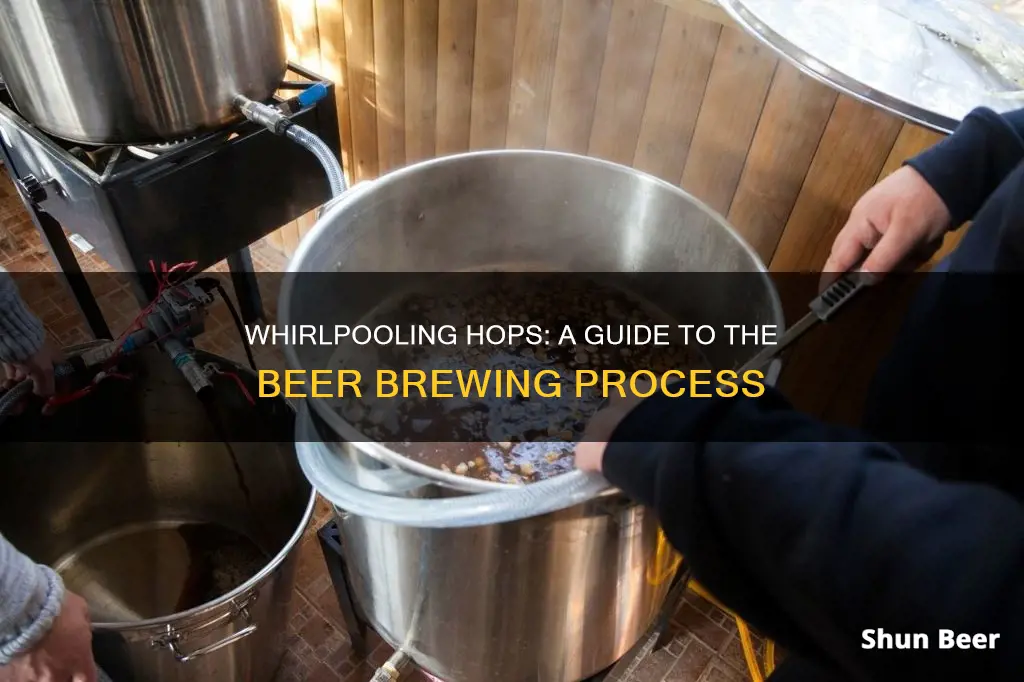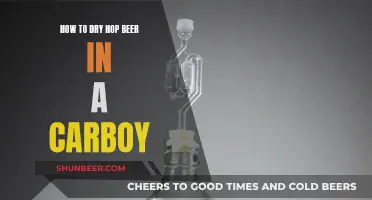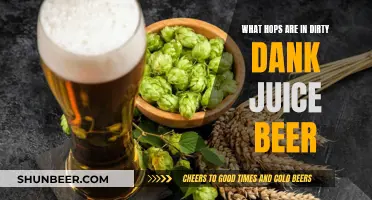
Whirlpool hopping is a technique used in brewing to separate hop pellets and trub from wort after boiling. The wort is pumped into a whirlpool vessel at a rapid velocity, causing it to spin like a whirlpool. This process helps to settle the trub and separate the hops and trub from the wort. Whirlpool hopping is particularly important for capturing volatile hop aroma oils, as these have a lower boiling point than water and will quickly boil off if added during the boil. While whirlpool hops can add some bitterness to the beer, the main purpose is to extract and preserve the aroma oils found in hops.
What You'll Learn

Whirlpool hopping is a technique where hops are added after flame-out
To perform whirlpool hopping, the wort is pumped into a whirlpool vessel at a rapid velocity, usually about 15 feet per second, to create a whirlpool effect. This pumping process lasts for 10 to 20 minutes, after which the wort is allowed to stand for an additional 20 minutes or so. During this time, the hops and trub form a compact pile in the center of the vessel, which can then be easily separated from the wort.
The temperature and duration of the whirlpool are important factors in the process. Whirlpool hopping is typically done in the range of 150-210°F (66-99°C). At higher temperatures, more bitterness is added to the beer, while at lower temperatures, more aroma oils are preserved. The duration of the whirlpool also affects the amount of bitterness and aroma in the beer.
Whirlpool hopping is a common method used in commercial breweries, and it has become essential for packing flavor into IPAs and other hop-forward beers. Homebrewers can also perform whirlpool hopping using a large spoon to stir the wort in a circular motion.
Hops Beer: The Secret Behind the Bitter Buzz
You may want to see also

Whirlpool hopping captures volatile hop aroma oils
Whirlpool hopping is a technique where hops are added after the flame-out and allowed to steep at a high temperature for a period before the wort is chilled. This technique is used to capture volatile hop aroma oils in the beer.
The aroma oils in hops have a boiling point lower than that of water, so they will quickly boil off if the hops are added during the boil. Therefore, hops are added either in the whirlpool or as dry hops to preserve these oils. Whirlpool hopping uses the elevated temperature of the unfermented wort to infuse the oils.
The four primary hop oils are myrcene, humulene, caryophyllene, and farnesene. Myrcene is the dominant oil in most hop varieties and has a distinctive "green hop aroma" with herbal, piney, and citrusy hints. Humulene is the classic noble hop oil with a strong herbal component. Caryophyllene provides earthy, woody, and spicy tones, while farnesene is typically only found in noble hops and provides flowery, green apple, or woody notes.
Whirlpool additions can be done at different temperature ranges. The high isomerization range (185–210°F/85–99°C) is where some hop alpha acids are still isomerized, adding bitterness to the beer. The medium whirlpool range (160–170°F/71–76°C) has little isomerization, so it adds minimal bitterness while also reducing volatilization, preserving more hop oils. The low whirlpool range (150–160°F/60–66°C) volatilizes the fewest hop oils but requires a longer whirlpool time due to lower solubility.
While whirlpool hopping is a quick method for capturing hop aroma oils, it does have some drawbacks. There is a risk of losing some low vapor point aromatics through evaporation, and a significant portion of the aromatic oils infused can be lost during fermentation due to the rapid rise of CO2 bubbles.
Hops: Brewing Demand and Future Growth
You may want to see also

Whirlpool hopping reduces bitterness
Whirlpool hopping, or "steeped" hopping, is a technique where hops are added to the beer after the boil and allowed to steep at high temperatures before the wort is chilled. The primary purpose of whirlpool hopping is to capture volatile hop aroma oils, as opposed to adding bitterness. Most aroma oils in hops have a lower boiling point than water, so they will quickly boil off if added during the boil.
However, whirlpool hopping will still add some bitterness to the beer. This is because isomerization of the alpha hops creates isomerized alpha acids, which are the main bittering compounds in beer. The temperature and time of whirlpool additions are crucial, as the hops are added at a lower temperature, and the isomerization process occurs at a much slower pace.
For example, at 90°C (194°F), the isomerization rate is 49%, while at 80°C (176°F), it drops to 23%. At 70°C (158°F), the rate is 10%, and at 60°C (140°F), it is only 4.3%. Therefore, whirlpool hopping at lower temperatures will result in less bitterness being imparted to the beer.
Additionally, the effect of boil hops that are carried over into the whirlpool should also be considered. Hops added towards the end of the boil will still have a significant amount of alpha acid left when the whirlpool stage begins, and they will continue to contribute some bitterness.
In summary, while the main goal of whirlpool hopping is to capture aroma oils, it will also add some bitterness. However, by controlling the temperature and time of the whirlpool additions, brewers can minimize the bitterness and focus on extracting the desired aroma compounds from the hops.
Green Hop Beer: Fresh, Aromatic, and Seasonal Treat
You may want to see also

Whirlpool hopping is used to separate hop pellets and trub from wort
Whirlpool hopping, also known as "steeped" hopping, is a technique used in beer brewing to separate hop pellets and trub from wort. It is a common method in commercial breweries and can also be done by homebrewers. The process involves pumping the wort into a whirlpool vessel at a rapid velocity, causing it to spin like a whirlpool. This helps to separate the hop pellets and trub, which form a compact pile in the centre of the vessel, from the wort.
The main purpose of whirlpool hopping is to capture volatile hop aroma oils, such as myrcene, humulene, caryophyllene, and farnesene, in the beer. Most of these aroma oils have a boiling point lower than that of water, so they will quickly boil off if added during the boil. By adding the hops after the boil, in the whirlpool, or as dry hops, brewers can preserve these oils.
While the primary goal of whirlpool hopping is not to add bitterness, it does still contribute some bitterness to the beer due to isomerization of the alpha hops. The temperature and time of whirlpool additions are crucial, as the isomerization process occurs more slowly at lower temperatures.
Whirlpool hopping also offers additional benefits, such as quicker chilling of the wort, clearer wort by collecting cold break solids in the centre, and reduced dimethyl sulfide (DMS) formation, resulting in improved hop flavour and aroma.
Overall, whirlpool hopping is a valuable technique in beer brewing that helps to separate hop pellets and trub from the wort while also enhancing the flavour and aroma of the final product.
Dry Hopping Beer: Pellet Power for Aromatic Brews
You may want to see also

Whirlpool hopping is used to make the wort clearer
Whirlpool hopping is a common method used in commercial breweries to separate hop pellets and trub from wort after the wort boil. The process involves pumping the wort into a whirlpool vessel at a rapid velocity, causing it to spin like a whirlpool. This rapid motion helps to separate the cold break solids and collect them in the centre of the brew kettle, resulting in a clearer wort.
The wort is pumped into the whirlpool vessel at a high speed, typically about 15 feet per second. This causes the wort to circulate and creates a centrifugal force that pushes the solids to the centre of the vessel. The wort is then allowed to stand for 10 to 30 minutes, during which the hops and trub form a compact pile in the centre. The clearer wort can then be easily siphoned off from the side of the kettle or through a valve, avoiding the transfer of any particulate matter.
Homebrewers can also achieve whirlpooling by using a large spoon to stir the wort persistently in a circular motion in one direction. This generates a mini-whirlpool effect, separating the hops and trub from the wort. After stirring, the wort is allowed to rest for 10 to 20 minutes before being drained into a wort cooler.
The main purpose of whirlpool hopping is not to add bitterness but to capture volatile hop aroma oils. Most aroma oils in hops have a boiling point lower than water, so they will quickly boil off if added during the boil. By adding hops during the whirlpool process or as dry hops, these aroma oils can be preserved.
While whirlpool hops are primarily used for capturing aroma oils, they can also contribute to bitterness. This is because the hops are added at a temperature where isomerization still occurs, creating isomerised alpha acids, which are the main bittering compound in beer. Therefore, whirlpool hopping can provide a smoother bitterness to the finished beer.
Dry Hopping Beer: Timing and Techniques for Flavorful Brews
You may want to see also
Frequently asked questions
Whirlpool or "steeped" hopping is a technique where hops are added after flame-out and left to steep at a hot temperature for a period of time before the wort is chilled.
The main purpose of whirlpool hopping is to capture volatile hop aroma oils in the beer. It is also used to improve the clarity of the wort by collecting cold break solids in the centre of the brew kettle.
Whirlpool hops are usually added at a specific temperature and held at that temperature for a specific period of time. There are three temperature ranges that are used: high (185–210°F/85–99°C), medium (160–170°F/71–76°C), and low (150–160°F/60–66°C).
Whirlpool hopping can be done using various techniques and equipment. The simplest way is to stir the kettle's contents rapidly with a spoon until a circular current is achieved. This can also be done using a pump or counterflow chiller.







